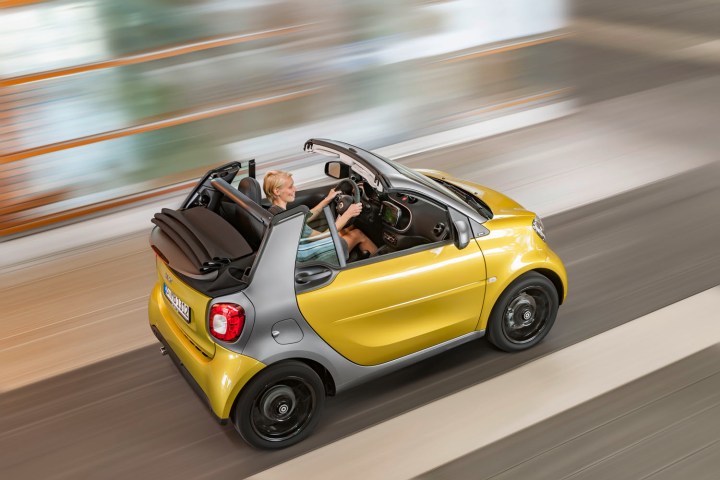
Those prices apply to the base Passion model, but buyers can also trade up to the Prime and Proxy trim levels. Regardless of what whimsically named trim level you choose, the Fortwo Cabrio comes with a 0.9-liter turbocharged three-cylinder engine, just like the current Fortwo coupe. The tiny engine sends 89 horsepower and 100 pound-feet of torque to the rear wheels.
The Fortwo Cabrio debuted at the 2015 Frankfurt Motor Show last year. It’s based on the same platform as the 2016 Fortwo coupe. Rather than introduce both body styles at the same time, Smart decided to launch the coupe as a 2016 model and give the convertible Cabrio a year off. The Cabrio will arrive in U.S. showrooms about a year after it was first shown in Frankfurt, and just as the weather starts to become less than optimal for driving with the top down.
Read more: Brabus’ 860 6.0 Biturbo Cabrio is a 217-mph convertible
Equipped with a new “Tritop” roof, the Fortwo Cabrio lets drivers motor with the top fully open, fully closed, or partially open, like a big sunroof. The roof takes 12 seconds to open, something that can be done on the move. It can even be operated remotely using the key fob. However, drivers still must manually remove and stow a pair of side bars to fully open the roof.
In addition to the new convertible top and updated platform, the Fortwo Cabrio gains some new driver-assistance systems. Standard Crosswind Assist helps to correct for gusts, something that will probably be appreciated in the tall, narrow Smart. Hill-Start Assist is standard as well, and forward collision warning is optional.
The next Smart Fortwo variant will be a redesigned version of the Electric Drive model. Set to debut at the 2016 Paris Motor Show, it will switch over to the new Smart platform. Like the current model, it will probably be offered as a coupe or convertible.
Editors' Recommendations
- Wyze Cam v3 works indoors and outdoors, all for just $20
- The Lifx Clean smart light bulb can sanitize surfaces with just its light
- Microsoft offers up to $20,000 to identify security vulnerabilities in Xbox Live
- Did Tesla release an unfinished Smart Summon just to pull an accounting trick?
- Survey: Many people want to use their smart TVs for more than just watching shows


